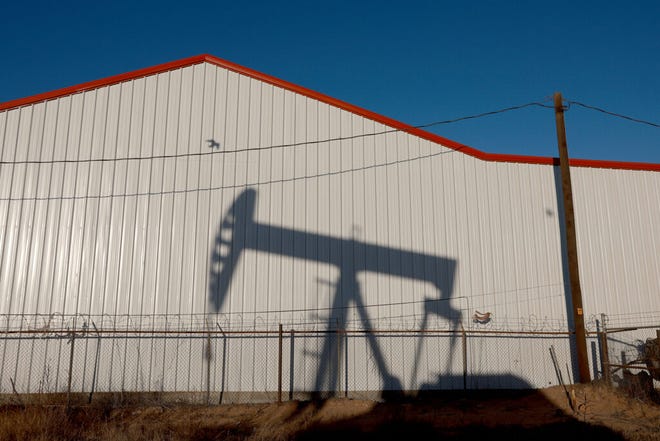[ad_1]

This story was originally published by Source New Mexico.
New Mexicans will decide in the General Election if a new official will come in to manage state land or go with an incumbent that supports renewable energy while overseeing the largest production from extractive businesses in state history.
The N.M. commissioner of public lands is in charge of leasing state land for a place where billions in revenue generated by the oil and gas industry funds public schools and state government operations.
Democratic incumbent Stephanie Garcia Richard leased over 100,000 acres of land for oil and gas production, as of September, in her first term. She said New Mexico enjoys billions of dollars from oil and gas revenue but wants to diversify that funding for when it can’t always deliver that much to the state.
Her opponents, Republican Jefferson Byrd and Independent Larry Marker, want to see the booming oil and gas industry grow even further. While they think renewable energy will become more prominent in the future, they both said extraction and production should remain the priority right now.
Although the amount of acres leased has decreased since Garcia Richard started in 2019, New Mexico has produced record amounts of gas and oil during those four years.
At the same time, she tripled renewable energy production in her first term. She created a Renewable Energy Office within the state land office that’s focused on dozens of solar and wind energy projects.
Despite her efforts to diversify the state’s revenue, she said that renewable energy projects won’t make up for the money oil and gas generates. She said there need to be multiple diversification efforts to start to make up the revenue, but even then it won’t be equal.
“I don’t think that we have a revenue resource that’s going to be dollar for dollar,” Garcia Richard said.
The ups and downs of the oil and gas industry
The oil and gas industry operates on a boom and bust cycle, thriving at some times but not at others.
Garcia Richard pointed this out and said the volatility of the oil and gas market is at the mercy of the industry internationally. Having served on the state Legislature during a previous bust for oil and gas, she said, she had to sit on a budget committee and cut funding for services like health care, education and other programs.
Marker acknowledged the extreme highs and lows of the industry but said it would still be advantageous for the next public lands commissioner to support growth within the oil and gas industry. With its high revenue, New Mexico can keep putting money aside in good years to have a surplus for bad years, like it currently does with the Land Grant Permanent fund, as well as pay off debts.
“I’m going to be an advocate for oil and gas production, but I also know that there are extreme highs and extreme lows,” Marker said.
Believe me, I’ve had to count change out of my ashtray to buy enough fuel to go check my wells, and then a year later, I thought I’d never see another poor day.
Larry Marker
Larry Marker
Byrd said that volatility can actually be controlled domestically if the U.S. were to become more energy-independent by using its oil and gas supply, and stop relying on oil and gas from other countries. This would keep prices down at the pump, he said, since companies wouldn’t fear New Mexico cutting off oil and gas production.
“When they know the supply is going to meet the demand, prices automatically just start going down, and so just having a positive discussion about production rather than ending it helps the prices stay low,” Byrd said.
Cutting off production now or in the near future would be detrimental to the state, Byrd said.
Marker agreed.
“If you were just to end fossil fuel production right now, we would basically be going back to the Dark Ages,” Marker said.
Garcia Richard acknowledges the resource is limited. Although she said renewable energy can’t replace oil and gas revenue, she knows the fossil fuel resource will be gone eventually.
Oil and gas will be used up by 2060, according to Stanford’s Millennium Alliance for Humanity and the Biosphere.
“It’s a finite resource. It won’t always be here. It’s non-renewable,” Garcia Richard said. “So there will come a time when the resource has been depleted and we won’t be able to develop it in the volumes that we are doing now.”
Byrd disagrees with the projections, saying New Mexico has at least a century before oil and gas will be tapped out. However, his insight is based on some known, but also unknown energy reserves that the state and federal government haven’t tapped into yet.
“We haven’t even tapped into all the oil and gas reserves known to exist in the continental U.S.,” Byrd said. “There’s still more oil and gas.”
Keeping the environment in mind
Money isn’t the only issue.
The negative impacts to the environment and people’s health, as well, is a concern, Garcia Richard shared. The oil and gas industry produces toxic air and water pollution.
She set a moratorium on the Greater Chaco Region in 2019 to protect archaeological and cultural resources for Indigenous people. The Biden administration followed the lead, creating a review period that ceased new permits for mineral extraction on federal land, supporting the state efforts Garcia Richard signed. The federal government has also given more protections for natural lands in Chaco and the Bears Ears National Monument located in Utah.

But Marker said Garcia Richard champions too heavily on the side of the environment.
He said the state land office should be neutral from politics as the original intention for it was to generate as much revenue as possible while preserving the land, not serving the governor or Legislature. Instead of answering to environmentalists or large oil companies, he said, he would only answer to New Mexicans.
He said Garcia Richard’s moratoriums on oil and gas put smaller oil and gas producers out of business. Technology can be improved upon to better protect the environment and keep up extraction and production, he added.
“Being an independent oil and gas producer who is just almost out of business, I’m fully aware of the environmental concerns…” Marker said. “But I’m also realistic.”
Byrd said oil and gas companies are continuously looking for ways to better monitor and capture greenhouse emissions so they don’t lose revenue, Byrd said.
“Their goal is the same as ours. They don’t want to lose that revenue source because of the potential,” Byrd said.
The road to renewable energy
Garcia Richard said the state needs to keep renewable energy work going. She said renewable energy projects increased and quadrupled in revenue, producing $5 million in the past to $20 million under her term.
“This is now for the first time real money to start to ensure that revenue continues to come to the beneficiaries, continues to fund these very important institutions in our state, like public schools, universities and hospitals,” Garcia Richard said.
Byrd said that alternative energy work had to materialize when the Legislature passed the Energy Transition Act in 2019, mandating future renewable energy standards. He said he would keep that work going as required by the act.
“It’s just by luck that the Legislature passed the law that that’s occurring, and it wasn’t something that she sought out to do on her own, and it’s not something I would stop,” Byrd said. “I mean, that’s the job of the land commissioner is to utilize the lands for the benefit of the state.”
Byrd and Marker said future investments for new energy models should be made, but oil and gas production should be allowed to thrive right now.
“I believe we need to focus on what we have right now with one eye looking down the road knowing that there is a brighter day ahead,” Marker said.
To better understand the materials and mining resources available for alternative energy projects, Byrd said he would want to do an updated geological survey in the office of the land.
Garcia Richard already has renewable energy projects she wants to continue, with wind and solar energy, storage capacity and transmission initiatives in mind. Marker said he believes solar and wind technology will be the future.
But this renewable energy is dependent on batteries, the primary method of renewable energy storage. Marker said battery technology is lagging, which impacts how effective renewable energy would be in replacing fossil fuels. The market would move ahead rapidly if America focused on improving that tech instead of relying on other countries for it, he said.
“What our holdup is is we’re depending on other countries and other people for the materials we need to move that technology forward,” Marker said.
Uranium mining
Another revenue source Marker said the state needs to utilize is nuclear energy. New Mexico is one of the top state’s for uranium mine reserves, Marker brought up, and he said the industry could potentially replace the fossil fuel industry in a couple of decades.
Uranium mining has a messy history in New Mexico. There are hundreds of abandoned mines that continue to poison residents that New Mexico is still trying to clean up.
Marker said New Mexico needs to make nuclear energy production cheaper and safer. Part of that would come from companies coming in to mine the uranium, he said, and cleaning up any of their own messes as well as those left by others with profits from the uranium.
Although it’s a touchy subject and wasn’t done well in the past in New Mexico, he said, it can generate revenue for the state in a manner responsible to the land.
“We’ve done a really good job of destroying the mining industry in New Mexico, including the uranium miners,” Marker said.
Byrd said it’s really up to the courts and Legislature to allow uranium mining again. The public lands commissioner would just set up the contract, he said, and make sure the land is being protected.
“As long as it’s done right and done with the best available technology, people are protected, then we do it here,” Byrd said. “And if we can’t do it here in that kind of manner, it really shouldn’t be done anywhere.”
But Garcia Richard said that industry can’t be reopened again until parties are held responsible for their consequences through legal agreements tying them to financial compensation and clean-up, which she isn’t aware exists.
“I would never start to even contemplate starting uranium mining up again in the state until we have addressed the legacy issues that have been left behind,” she said.
The impact of the mining in the past has been severe on New Mexico and its people, Garcia Richard said. She brought up that the largest spill in the country happened in Church Rock, and people got sick and still have lingering medical issues from pollutants left abandoned.
“Now as a state, we are left holding the bag to clean up these toxic mines,” she said, “and I think it’s a good lesson for us into the future on whether or not we should be doing these kinds of activities in New Mexico.”
Megan Gleason is a reporter for Source New Mexico.
Others are reading:
[ad_2]
Source link








